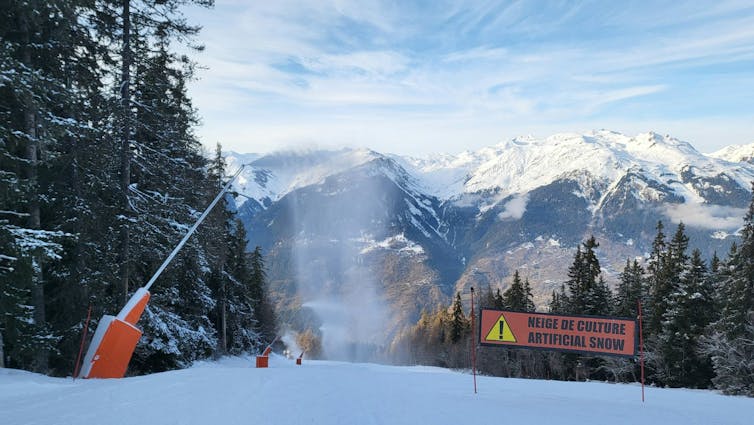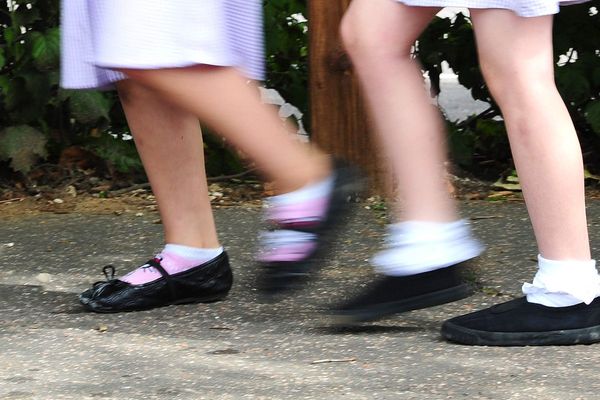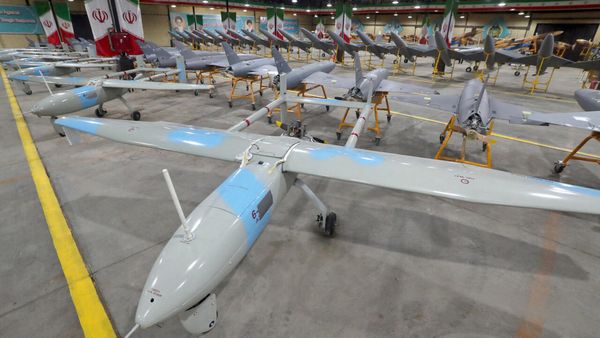Winter hasn’t arrived yet, but French ski resorts are already resorting to snowmaking. Milder temperatures as a result of climate change have effectively led to its use becoming entrenched in recent years, with 29% of French ski slopes area equipped with snowmaking machines, such as snow propeller canons or snow lances. Snow is manufactured by spraying micro-droplets of water in a cold atmosphere, which solidify before they hit the ground. The consistency is close to that of compacted snow.
There has been no shortage of criticism of this production method, which started to be aired in the mid-2000s. In September 2023, the mayor of La Clusaz, a commune to the west of Chamonix, decided to suspend the construction of a reservoir that would have largely supplied water for snow manufacture, following years of opposition from environmental organisations. As the climate crisis worsens, the suitability of this adaptive technology is likely to inspire more debate.
In a journal article, we uncovered the ways the winter sports industry is locked in a state of dependency around snowmaking.
Freedom from bad winters
Snowmaking has been developed by the French winter sports industry since trials began in 1973. The technology is increasingly deployed as a regular tool to improve conditions on the slopes. From 2005-2016, snowmaking accounted for 20% of spending by ski resort managers – the second biggest area behind buying new ski lifts.
Today, this industry doesn’t only absorb the attentions of ski operators, but all players in the winter sports sector. Estate agents for apartments offering “ski-in, ski-out” facilities; tour operators seeking guarantees for their package deals; alpine communities hoping for skiing to come back to their village – all pray that snowmaking blesses their projects.
Despite the rise of this technology and technical advances being made, changing weather conditions under climate change is a limiting factor. The snowmaking process doesn’t free operators from constraints such as the need for sub-zero temperatures and dependence on a plentiful water supply. Now, the effects of climate change are reducing the snow cover depth as well as opportunities to produce snow.
Even though future climate factors risk limiting the effectiveness of snowmaking, moving away from it seems difficult for the winter sports sector. This situation has only recently been analysed.
A classic ‘path dependence’
We show in our research that snowmaking has driven the winter sports industry down an unquestionable “path dependence”. Prior choices of investing in this technology and the increases in snow cover achieved in the past encourage continued spending, starving other activities of resources, whether economic or natural, like water supply.
This path dependence is as likely to lead ski tourism down an expansionary route as one of contraction, with markedly different consequences for mountain regions.
To take the expansionary scenario – investing in snowmaking has shored up a seasonal, weather-dependent activity which displays the characteristics of a heavy industry. Essentially, developing a ski resort relies on significant capital investment, notably for the renewal of ski lift infrastructure, with fixed costs which reinforce a business’s exposure to economic risks linked to the natural variability of the weather. On top of this now comes expertise and increasingly sophisticated techniques for snowmaking, plus the growth of dedicated services.

Ultimately, snowmaking secures a tourism offer for France within the mature and competitive European ski market. Generating snow helps retain France’s market share – the third biggest in the world for winter sports behind the US and Austria with 50 million ski days a year and 27% of international ski tourists.
An estimated 10% of French people take part in winter sports each year, corresponding to 7% of domestic visitors’ overnight stays in metropolitan France. Moreover, France’s 250 ski resorts are estimated to sustain more than 120,000 jobs.
Some much-needed, but overdue changes
However, snowmaking could also go down a route of contraction. Outlays of investment in snowmaking only really benefit the ski industry – maintaining a sectoral specialisation of the economy in winter sports tourism. This risk of over-specialisation can have knock-on effects on mountain regions as a whole. This may delay the inevitable changes and lessen the impact of steps aimed at diversifying Alpine economies.
Thus a vicious circle forms – the bias toward investment in snowmaking equipment captures resources which could be used to start the ball rolling toward eventual transition. This requires a co-ordinated economic and institutional response. It may be that the state has a role to play now, to help these areas break free from a dependence on skiing – indeed from tourism altogether – amid the reality of climatic and environmental change.
———rre
The IDEX UGA project is supported by the French National Research Agency (ANR), which funds project-based research in France. Its mission is to support and promote the development of fundamental and applied research in all disciplines, and to strengthen the dialogue between science and society. For more information, visit the ANR website._
Translation from French to English by Joshua Neicho.
Lucas Berard-Chenu has received joint funding from the French National Research Agency ('Agence nationale de la recherche') as part of the programme 'Investissements d'avenir' (reference ANR-15-IDEX-02) and the country's national weather agency, Météo-France. Lucas Berard-Chenu has also benefited from funding from the European Union's 2020 Horizon research programme (730203).
The research laboratory to which Emmanuelle George belongs (INRAE-LESSEM, Lyon-Grenoble center) has receive dfundings from various public and private organizations for its research.
The research laboratory to which Hugues François belongs (INRAE, Lyon Grenoble Center, LESSEM) has received funding from various public and private organizations for its research projects
The research laboratory to which Samuel Morin belongs (CNRM, Météo-France - CNRS) has received funding from various public and private organizations for its research projects.
This article was originally published on The Conversation. Read the original article.







